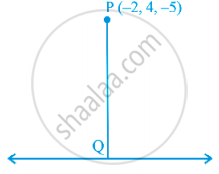Advertisements
Advertisements
Question
Find the distance of the point (– 2, 4, – 5) from the line `(x + 3)/3 = (y - 4)/5 = (z + 8)/6`
Solution
Here P (–2, 4, – 5) is the given point.
Any point Q on the line is given by `(3lambda - 3, 5lambda + 4, (6lambda - 8)`
`vec"PQ" = (3lambda - 1) hati + 5lambdahatj + (6lambda - 3)hatk`.
Since `vec"PQ" ⊥ (3hati + 5hatj + 6hatk)`, we have
`3(3lambda - 1) + 5(5lambda) + 6(6lambda - 3)` = 0
`9lambda + 25lambda + 36lambda` = 21
i.e. `lambda = 3/10`
Thus `vec"PQ" = - 1/10 hati + 15/10 hatj - 12/10 hatk`
Hence `|vec"PQ"| = 1/10 sqrt(1 + 225 + 144)`
= `sqrt(37/10)`.
APPEARS IN
RELATED QUESTIONS
Find the distance between the pairs of points:
(2, 3, 5) and (4, 3, 1)
Find the distance between the following pairs of points:
(–3, 7, 2) and (2, 4, –1)
Verify the following:
(0, 7, –10), (1, 6, –6) and (4, 9, –6) are the vertices of an isosceles triangle.
Verify the following:
(0, 7, 10), (–1, 6, 6) and (–4, 9, 6) are the vertices of a right angled triangle.
Find the equation of the set of points which are equidistant from the points (1, 2, 3) and (3, 2, –1).
Find the distance between the following pairs of points:
P(1, –1, 0) and Q(2, 1, 2)
Find the distance between the following pairs of point:
A(3, 2, –1) and B(–1, –1, –1).
Using distance formula prove that the following points are collinear:
A(3, –5, 1), B(–1, 0, 8) and C(7, –10, –6)
Determine the points in yz-plane and are equidistant from the points A(1, –1, 0), B(2, 1, 2) and C(3, 2, –1).
Show that the points (0, 7, 10), (–1, 6, 6) and (–4, 9, 6) are the vertices of an isosceles right-angled triangle.
Show that the points A(1, 3, 4), B(–1, 6, 10), C(–7, 4, 7) and D(–5, 1, 1) are the vertices of a rhombus.
Prove that the tetrahedron with vertices at the points O(0, 0, 0), A(0, 1, 1), B(1, 0, 1) and C(1, 1, 0) is a regular one.
Show that the points (3, 2, 2), (–1, 4, 2), (0, 5, 6), (2, 1, 2) lie on a sphere whose centre is (1, 3, 4). Find also its radius.
Find the centroid of a triangle, mid-points of whose sides are (1, 2, –3), (3, 0, 1) and (–1, 1, –4).
Write the coordinates of third vertex of a triangle having centroid at the origin and two vertices at (3, −5, 7) and (3, 0, 1).
Find the distance of the point whose position vector is `(2hati + hatj - hatk)` from the plane `vecr * (hati - 2hatj + 4hatk)` = 9
Prove that the line through A(0, –1, –1) and B(4, 5, 1) intersects the line through C(3, 9, 4) and D(– 4, 4, 4).
Find the equation of a plane which is at a distance `3sqrt(3)` units from origin and the normal to which is equally inclined to coordinate axis
Distance of the point (α, β, γ) from y-axis is ______.
The distance of the plane `vecr * (2/4 hati + 3/7 hatj - 6/7hatk)` = 1 from the origin is ______.
The points A(5, –1, 1); B(7, –4, 7); C(1, –6, 10) and D(–1, –3, 4) are vertices of a ______.
